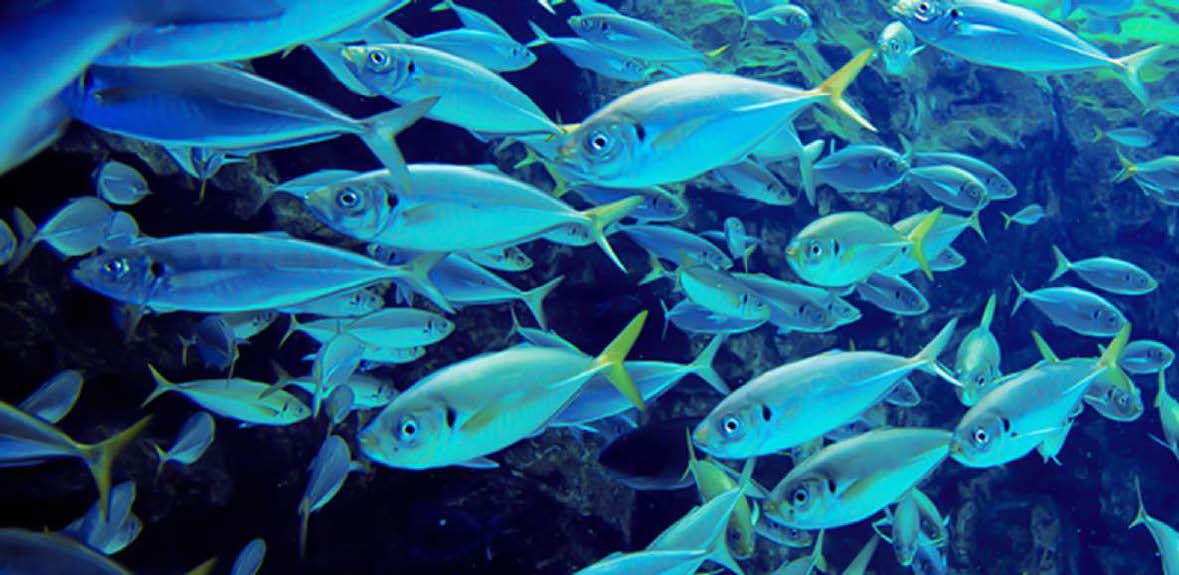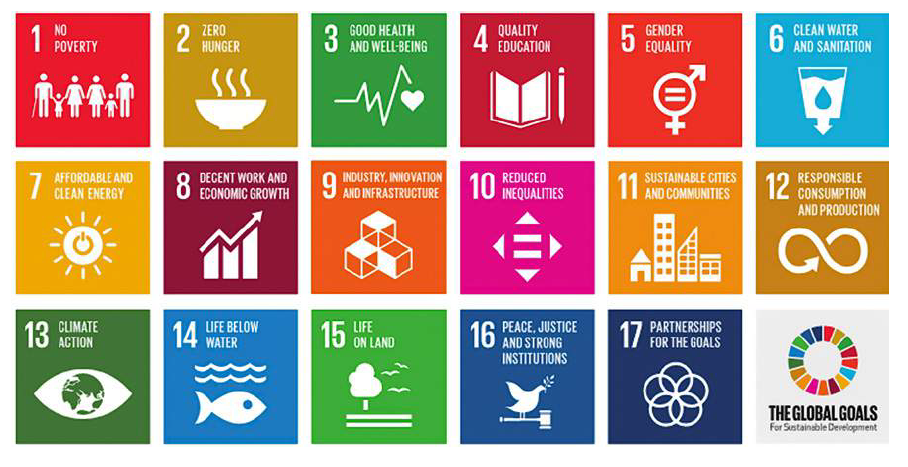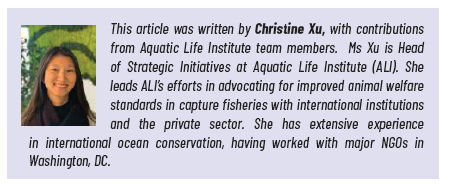Article II 3/2024: AQUATIC ANIMAL WELFARE ADVOCACY FOR SUSTAINABLE DEVELOPMENT AND A BETTER WORLD

Addressing aquatic animal welfare is essential and extends beyond ethical considerations, as it impacts areas of environmental, social and governance (ESG) risks that companies must consider. Improving aquatic animals’ well-being has far-reaching implications for sustainable development, including poverty eradication, food security, environmental preservation, public health, and social equity. One, some, or all of the afore-mentioned issues carry weight with the choices a consumer makes, and at times what choices they actually have, thus impacting overall consumer demand.
Consumers tend to turn to seafood labeling schemes for guidance to avoid purchasing products that conflict with sustainable and humane aquaculture practices. As institutions certifying aquatic animal products begin incorporating positive welfare standards into their seafood labeling programs, the aim is to define “high-welfare" products based on the best available scientific evidence rather than relying on subpar industry norms.
Aquatic Life Institute works with seven leading global seafood certification schemes to create a comprehensive assessment of the inclusion of current welfare requirements within their primary farming standards. While this is an evolving process, it is evident that a focus on welfare is becoming increasingly common in their assessments. The amount of certified aquatic animal products is only expected to increase, particularly considering consumers’ increasing demand for sustainable seafood, and in response, Aquatic Life Institute’s partners have been strengthening their animal welfare standards year over year
There is strong evidence for the increasing demand for sustainable seafood. Some 79% of European citizens said that fish welfare should be better protected than it is currently, and that the welfare of fish should be protected to the same extent as other animals eaten by humans, according to a survey of 9 000 people by ComRes, 2019. The report, which was commissioned by Eurogroup for Animals and Compassion in World Farming, states that people are looking for welfare standards when they buy fish products, as it likely indicates quality and freshness. The report can be accessed here.
Nearly 80% of Latin Americans would buy only certified animal welfare products if they were available on the market, according to the First Latin American Study on Consumption and Animal Welfare, commissioned by the NGO World Animal Protection in 2016. This report shows that more ethical, higher quality, and more environmentally sustainable is the preference of Brazilian, Chilean, Colombian, and Mexican consumers when it comes to animal products.
What defines aquatic animal welfare?
Aquatic Life Institute believes that, to measurably improve welfare, aquatic animal welfare standards must be species- and life stagespecific. Welfare standards should not only prevent the most harmful practices, but also provide a positive environment where healthy aquatic animals can express their species-specific behavioural needs and preferences, and experience positive effects.
To help define what high welfare means for aquatic animals, Aquatic Life Institute sought feedback from global experts between 2019 and 2020, and together with our Aquatic Animal Alliance members, the first-ever comprehensive guide to aquatic animal welfare was published in late 2020 and can be viewed here.
Relevant to this article, the guide identified five pillars of aquatic animal welfare and their key interventions, using the Five Freedoms (developed by the UK Farm Animal Welfare Council) as guiding principles. The following is a brief overview:
• Enriched environment: Create an environment that meets speciesspecific ethological needs analogous to their ideal habitat;
• Feed composition and feeding: Reduce the amount of wild-caught fish required for aquaculture feed by researching alternative feed sources, improving feed conversion ratios, and substituting carnivorous farmed species with herbivorous species. Strive
for the most optimal feeding times and quantities and avoid starvation periods exceeding 72 hours;
• Space requirements and stocking density: Maintain appropriate space by species and life stage to avoid negative physical, psychological, and behavioural impacts;
• Water quality: Key water quality indicators should be monitored continuously, or at least once a day; and
• Stunning and slaughter: All animals must be effectively stunned before slaughter while the time elapsed between stunning and slaughter must be minimized in order to lower the risk of consciousness being recovered.
Though this article does not focus on further exploring these five pillars of aquatic animal welfare, they are essential to explore when considering the importance of welfare policies for consumer demand and corporate responsibility.
How aquatic animal welfare pays off in the private sector
Environmental
Responsible and gentle capture, handling and slaughter methods by fishing vessels can reduce habitat destruction, biodiversity loss, carbon emissions and plastics pollution.
Social
Reducing avoidable mortality and bycatch rates in fishing improves food and nutrition security. Welfare-focused handling of aquatic animals minimizes risks to worker safety.
Governance
Global focus on animal welfare in capture fisheries is quickly evolving in real-time; for example, UN Ocean Decade Action, EU Animal Welfare Legislation, UK Animal Welfare Act of 2022.
Quality
Improved animal welfare produces better quality products, longer shelflife, and can command higher prices.
Corporate social responsibility
Businesses that fail to address animal welfare in their policies will likely face legal and financial consequences under new standards, laws and regulations. With rising consumer awareness and demand for the humane treatment of animals, including aquatic animals, the private sector should incorporate animal welfare policies in addition to labour rights and environmental sustainability policies.
Being proactive in adopting aquatic animal welfare commitments before mandatory legislation comes into place, and/or negative public perception surfaces, goes a long way in protecting a company’s reputation, financial stability, and stakeholder relationships.
Moral obligation
Aquatic animals, who are capable of feeling and perceiving similar to land animals, remain unprotected by law and fisheries management bodies. Therefore, the corporate sector has a moral duty to ensure that the aquatic animals involved in their business are treated humanely.
Corporations for aquatic animal welfare
Seafood businesses should learn about the main animal welfare risks stemming from both target and non-target species associated with different types of fishing gear, then design policies to minimize those risks in their supply chain.
Corporate animal welfare commitments in capture fisheries
To further illustrate how these commitments can be made in the private sector, Aquatic Life Institute launched its Corporate Animal Welfare Commitments in Capture Fisheries report earlier this year, which illuminates the benefits that can be gained from adopting aquatic animal welfare standards in corporate policies. The report gives details of the negative impacts of certain outdated practices in wild capture fisheries, then provides actionable recommendations for how they can be improved throughout all of their stages: capture, retrieval, onboard handling and live storage, and stunning and slaughter. The full report is viewable here.
Aquatic animal welfare and the SDGs
One crucial aspect that deserves attention in the context of the SDGs is animal welfare, which plays a significant role in both supporting and being impacted by multiple Goals. For aquatic animals, their welfare is intrinsically linked to not only SDG 14: Life Below Water, but the achievement of many other SDGs. Responsible and ethical fishing, handling and slaughter methods, such as species-specific fishing gear and humane stunning, can help prevent the destruction of fish populations and marine ecosystems. Improving their welfare has far-reaching implications for sustainable development.

Goal 1: Zero Poverty
Enhancing the welfare of aquatic animals in aquaculture and fisheries can contribute to poverty reduction by improving the productivity and sustainability of industries which provide income and employment opportunities for many communities, especially those in developing countries. Poor animal welfare practices can result in overexploitation of animals, decreased fish populations, loss of jobs, and economic loss.
Implementing sustainable and ethical fishing and aquaculture practices that prioritize the welfare of aquatic animals ensure the long-term viability of these industries, providing stable income sources and contributing to poverty reduction.
Goal 2: Zero Hunger
Aquatic animals can be important sources of protein and essential nutrients in many diets worldwide. By enhancing the welfare of these animals in aquaculture and fisheries, their overall health, growth, and productivity can improve. This, in turn, secures availability of nutritious food, contributing to a more secure and diverse food supply. Scaling back commercial fishing practices (implementing stricter catch limits and limiting destructive fishing practices) will help improve aquatic animal welfare and restore marine biodiversity and fish populations, improving food security for communities that rely on fish.
Goal 3: Good Health and Wellbeing
Improving the welfare of aquatic animals in aquaculture and fisheries contributes to safer and healthier seafood products by minimizing animal disease and infection. This reduces the need for antibiotics or other medications, resulting in safer food for consumers and less antibiotic resistance, protecting the health and well-being of people.
Goal 5: Gender Equality
Aquatic animal welfare considerations, which are often aligned with improved worker safety, can enhance labour conditions and standards, which is particularly relevant to women engaged in processing, marketing, and value-added activities. This can support women empowerment and access to fair and safe working conditions.
Goal 6: Clean Water and Sanitation
By prioritizing the welfare of aquatic animals, we minimize the negative impact of aquaculture and fishing activities on water ecosystems, ensuring cleaner and healthier water resources. Responsible welfare practices in aquaculture and fisheries can help minimize pollution, particularly from excess feed, waste, chemicals, and plastics. Proper feed management and waste treatment systems reduce nutrient runoff, eutrophication, and the accumulation of pollutants in water bodies. By improving animal welfare, we mitigate the negative environmental impacts associated with these industries, contributing to cleaner water and reduced pollution levels.
Goal 8: Decent Work and Economic Growth
Companies that do not prioritize labour rights or worker safety are not likely to prioritize animal welfare. And, implementing responsible welfare practices improves safe working environments and requires knowledge, skills, and training. By promoting the welfare of aquatic animals, there is a need to develop and enhance the capabilities of individuals working in the sector, which can lead to valuable skills and competencies, empowering them to secure decent work and contribute to economic growth.
Goal 10: Reduced Inequalities
Individuals from local artisanal fishing communities; marginalized groups, including indigenous communities; and disadvantaged populations, can benefit from aquatic animal welfare policies via collaboration and engagement with various stakeholders, and promoting inclusive governance and reducing power imbalances. Animal welfare practices in aquaculture and fisheries also align with environmental justice principles. This includes ensuring equitable and sustainable resource use, reducing inequalities in access to, and benefits from, aquatic resources.
Goal 12: Responsible Consumption and Production
Aquatic foods comprise the last major food-producing sector that does not take animal welfare into consideration. Aquatic animal welfare can improve responsible production by reducing the use of antibiotics; minimizing environmental impacts of fishing; limiting mortality rates; and optimizing feed efficiency derived from wild-caught fish. It can improve responsible consumption via supply chain policies changes so that consumers can make informed decisions about the products they purchase.
Further, target 12.6 highlights the importance of corporate responsibility in promoting sustainable practices throughout the value chain. In the context of fishing and seafood industries, it encourages companies to adopt sustainable fishing practices, minimize environmental impacts, and consider the welfare of aquatic animals. By integrating sustainability information into their reporting cycle, companies can transparently communicate their efforts to promote responsible consumption and production, including actions taken to ensure aquatic animal welfare.
Goal 13: Climate Action
Enhancing animal welfare practices in aquaculture, including optimizing feeding practices, reducing energy consumption, and minimizing nutrient runoff, all contribute to lower emissions. This is especially effective for carnivorous fish farms like salmon farms in which the majority of its emissions come from Scope 3 emissions due to the acquisition of fish meal and fish oil (e.g. capture, transport, processing). In fisheries, animal welfare policies can limit destructive fishing practices, such as bottomtrawling, which releases massive amounts of carbon. It can also limit overfishing to maintain the aquatic animals’ ability to store carbon.
Goal 14: Life Below Water
This Goal specifically focuses on the conservation and sustainable use of oceans, seas, and marine resources. It includes targets related to the reduction of marine pollution, protection of marine ecosystems, regulating illegal fishing, restoration of degraded coastal areas, eliminating harmful fishing subsidies, supporting small-scale fishers, and the conservation of marine biodiversity. All of these targets are either directly or indirectly related to improving aquatic animal welfare, as outlined below:
• By prioritizing animal welfare in aquaculture and fisheries, we promote sustainable practices that minimize the negative impacts on marine ecosystems. This includes protecting vulnerable species, preserving habitats, and reducing the risk of overfishing.
• Ecosystem health and resilience: Healthy animals play essential roles in the balance of ecosystems and contribute to the overall stability of marine environments. By ensuring their welfare, we help preserve the integrity of these ecosystems.
• Pollution reduction: Promoting animal welfare practices involves minimizing pollution in aquaculture and fisheries. Proper waste management, responsible use of chemicals, and reduction of nutrient runoff contribute to reducing pollution in water bodies.
• Marine capture fisheries are one of the largest contributors to ocean plastics pollution through abandoned, lost, or discarded fishing gear (ALDFG). Ghost gear continues to “fish”, entangling marine species, which can cause injury, death, starvation, exhaustion, and other issues. In addition to the animal welfare concerns around ghost gear, there are a number of environmental issues such as destruction of marine habitats (weakening ocean ecosystem and its ability to withstand climate change and other environmental disturbances); and loss of biodiversity, furthering the decline in aquatic animals. Solutions include mandatory marking of fishing gear, certifiers to include gear management in standards, and biodegradable fishing gear. See article for more details.
• Improving animal welfare aligns with the adoption of sustainable fishing practices. By promoting responsible fishing methods such as selective fishing gear, avoiding bycatch, reducing plastics pollution, and respecting catch limits, we help prevent the depletion of fish populations and the disruption of marine ecosystems. Ethical fishing
practices contribute to the restoration and maintenance of fish populations.
Goal 15: Life on Land
Although this Goal primarily addresses terrestrial ecosystems, it includes targets related to the conservation and restoration of inland water ecosystems such as rivers, wetlands and mangroves. By protecting and restoring these habitats, we not only enhance the welfare of aquatic animals but also provide important habitats for terrestrial species.
Goal 17: Partnerships for the Goals (cross-cutting)
Improving aquatic animal welfare requires collaboration among various stakeholders, including fishers, scientists, civil society, businesses and policymakers. By engaging these stakeholders and promoting dialogue, we foster a collective effort, knowledge exchange, technology transfer, and funding towards the conservation and sustainable use of marine resources.
Conclusion
Incorporating aquatic animal welfare considerations into policies, strategies, and practices is an urgent and essential task. Aquatic Life Institute, along with numerous other organizations in the Aquatic Animal Alliance, are focused on researching and developing materials that will help support businesses and producers with this crucial step forward. A full list of Aquatic Life Institute’s resources can be found here.
































